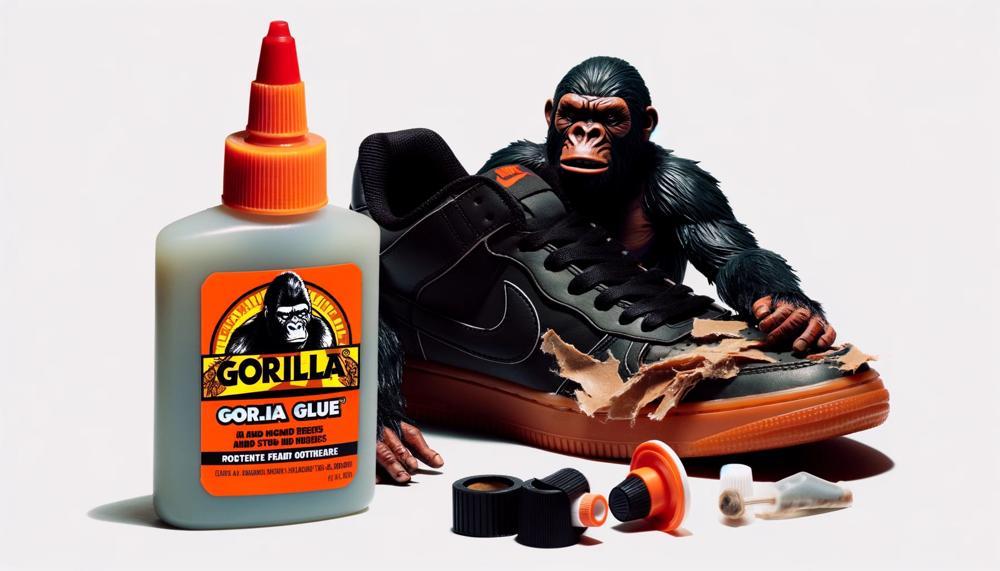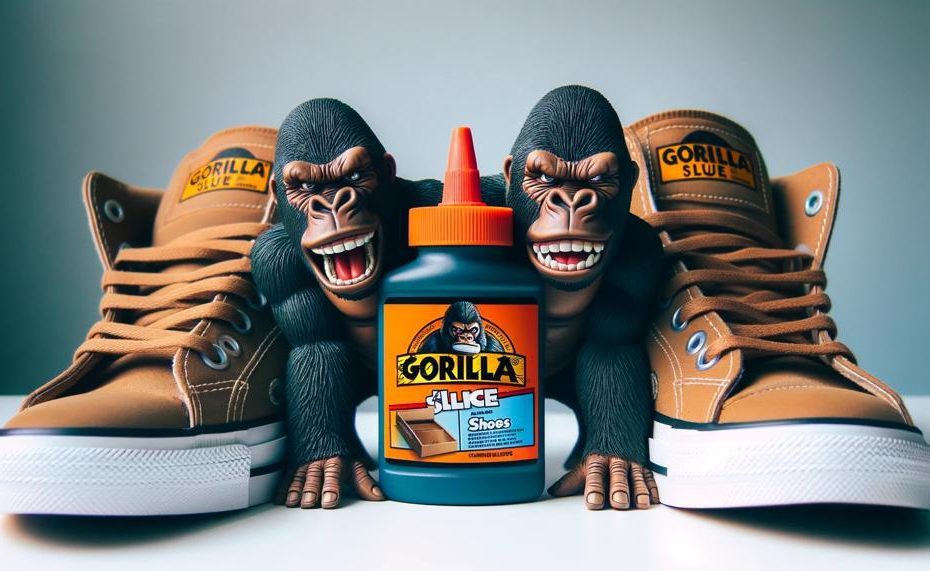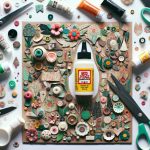Are you tired of constantly having to replace your shoes because the soles keep coming loose? Or perhaps you have a favorite pair of sneakers that are starting to show signs of wear and tear. Well, fear not my fellow shoe enthusiasts, because I have some game-changing information for you. It’s time to introduce the magical world of gorilla glue and its potential use on shoes.
So, can I use gorilla glue on shoes?
Yes, you can use Gorilla Glue on shoes. Gorilla Glue is a moisture-activated adhesive that works well on rubber, leather, and many other surfaces. It’s also 100% waterproof.
With these valuable insights, you can say goodbye to constantly replacing your beloved shoes and hello to a more cost-effective solution. Don’t let loose soles or worn out sneakers hold you back from looking stylish and feeling comfortable.
Let’s take a deep dive into the world of gorilla glue and revolutionize your shoe game.
Table of Contents
- 1 Can Gorilla Glue be Used on Shoes?
- 2 Considerations Before Using Gorilla Glue on Shoes
- 3 Cleaning and Preparing the Surface for Gorilla Glue
- 4 Applying Gorilla Glue to Shoes
- 5 Following Instructions for Best Results
- 6 Professional Shoe Repair vs. DIY with Gorilla Glue
- 7 Pros and Cons of Using Gorilla Glue on Shoes
- 8 Safety Precautions When Using Gorilla Glue
- 9 Conclusion
Can Gorilla Glue be Used on Shoes?
The question of whether Gorilla Glue can be used on shoes often arises when faced with a broken sole or a loose heel.
It’s tempting to reach for this strong adhesive, but before you do, consider the potential risks and benefits.
| Potential Risks: | |
| Messy Application | Gorilla Glue’s thick consistency can lead to messy application when too much is used or it is not applied correctly. This can result in unsightly glue stains and ruin the aesthetic of your shoes. |
| Incompatible with Some Materials | Not all shoe materials are compatible with Gorilla Glue, so it’s important to check before using it for repairs. For example, it may not work well on rubber or silicone-based soles and can even weaken over time with excessive wear and tear. |
| Requires Patience | Gorilla Glue takes time to reach its maximum bonding strength. Rushing the process by not allowing sufficient drying time can result in a weaker bond and possible future repairs. |
Benefits:
| Potential Benefits: | |
| Strong Bonding Strength | Gorilla Glue’s exceptional bonding strength makes it ideal for repairing shoes, as it can withstand everyday wear and tear. |
| Versatile | Gorilla Glue is compatible with various shoe materials such as leather, rubber, and canvas, making it a versatile option for shoe repairs. |
| Cost-effective | Compared to other options like Shoe Goo and Shoe-Fix Glue, Gorilla Glue is more affordable and easily accessible for shoe repairs. |
| Can be Used for Other Crafting Projects | In addition to shoe repairs, Gorilla Glue can also be used for other crafting projects involving shoes. |
| Dries Clear and Flexible | The flexible polyurethane formula of Gorilla Glue allows it to move and bend with the shoe without breaking the bond. It also dries clear and has a foaming agent to fill in gaps for a more seamless repair. |
To ensure the best results when using Gorilla Glue on your shoes, there are a few strategies you can employ. Varying your sentence structure and using shorter sentences and simpler words can help avoid repetition and make the content more engaging.
Considerations Before Using Gorilla Glue on Shoes
When it comes to using Gorilla Glue on your shoes, there are several important factors to consider beforehand. These considerations will not only help you achieve the best results but also prevent any potential damage to your shoes.
The first thing to consider is which type of Gorilla Glue is most suitable for your specific repair needs. Different products have varying bonding strengths and drying times, so it’s crucial to choose the right one for your shoes.
While Gorilla Glue is known for its strong bonding capabilities with materials such as leather, rubber, and plastic, it may not be compatible with all types of shoes. Some materials, like foam or specific fabrics, may not bond well with the glue, resulting in a weak or failed repair.

In addition to choosing the right type of glue and ensuring material compatibility, proper preparation of the bonding surfaces is essential for a successful repair. This includes thoroughly cleaning and roughening the surfaces before applying the glue to create a better bond.
Applying enough pressure during bonding and using clamps or heavy objects can also help achieve a tight bond between the shoe and the glue. This is especially important for repairing detached soles or seams.
Since Gorilla Glue has the ability to expand while drying, it’s important to protect any surrounding areas from excess glue. This will prevent any mess or damage to other parts of the shoe.
Different repairs may require different techniques when using Gorilla Glue. Whether you’re repairing ripped fabric, reattaching soles, patching holes, or sealing seams, it’s crucial to research and follow the recommended techniques for each specific repair.
To provide extra protection against moisture and wear, using a sealant after applying Gorilla Glue on your shoes is highly recommended. This is especially important for shoes that are regularly exposed to water.
While Gorilla Glue is water-resistant, extended exposure to water can weaken the bond over time. To ensure the durability of the repair, it’s best to avoid getting repaired shoes wet.
Last but not least, regularly assessing the condition of the adhesive and reapplying it as needed is crucial for maintaining the strength and durability of the bond.
Cleaning and Preparing the Surface for Gorilla Glue
Achieving a sturdy and long-lasting bond when using Gorilla Glue on shoes requires proper cleaning and preparation of the surface. Follow these recommended steps to ensure optimal results:
- Gather Necessary Materials: Before starting, gather all required materials including Gorilla Glue, mild soap, warm water, sandpaper or rough cloth, and clamps or heavy objects.
- Clean the Surface: Begin by thoroughly cleaning the affected area with warm water and mild soap. This will eliminate any dirt, dust, or oils that may interfere with the glue’s effectiveness. Make sure to dry the area completely before moving on to the next step.
- Roughen the Surfaces: Gently roughen the surfaces that will be bonded using sandpaper or a rough cloth. This will create a better surface for the glue to adhere to. Be cautious not to damage or remove too much of the shoe material.
- Apply Gorilla Glue: Use a brush or applicator to evenly spread a small amount of Gorilla Glue on one of the surfaces. Be careful not to use excess glue as it can create a mess and hinder proper bonding.
- Press Surfaces Together: Firmly press the surfaces together once the glue has been applied. This will ensure even distribution of the glue and prevent air pockets from forming.
- Use Clamps or Heavy Objects: To hold the surfaces in place while the glue dries, use clamps or heavy objects. Ensure they are positioned in a way that exerts even pressure on the surfaces. Leave them in place for the recommended drying time as stated on the glue’s instructions.
- Protect Surrounding Areas: To avoid getting excess glue on other parts of your shoes, protect surrounding areas using masking tape or painter’s tape.
Always refer to the manufacturer’s instructions for best results and safety precautions.
By properly cleaning and preparing the surface of your shoes, you can achieve a strong and durable bond when using Gorilla Glue.
Applying Gorilla Glue to Shoes
When it comes to fixing shoes, choosing the right adhesive is crucial. Gorilla Glue is a dependable and cost-effective choice for this task. However, proper application is key to ensuring a strong and long-lasting bond. Follow these steps for optimal results:
- Gather materials: In addition to Gorilla Glue, you will need a clean cloth, sandpaper or emery board, and clamps or heavy objects for even pressure.
- Clean and roughen surfaces: Before applying the glue, make sure the surfaces you are bonding are clean and free of any dirt or debris. Use a cloth to wipe down the areas that need to be repaired. Then, use sandpaper or an emery board to slightly roughen the surfaces. This will help the glue adhere better.
- Apply glue evenly: Using a small amount of Gorilla Glue, evenly spread a thin layer on one side of the repair area. It’s important not to use too much glue as it will expand as it dries.
- Firmly press together: Once the glue is applied, press the two surfaces together firmly. This will help distribute the glue evenly and create a strong bond.
- Use clamps or heavy objects: To ensure even pressure and a secure bond, use clamps or place heavy objects on top of the repaired area. This will prevent any gaps from forming between the surfaces.
- Protect surrounding areas: To avoid getting any excess glue on other parts of the shoe, use tape to cover the surrounding areas.
- Allow to dry: Gorilla Glue takes 30 seconds to start drying and 24 hours to fully cure. It’s important to wait for this amount of time before wearing the shoes again.
Following Instructions for Best Results
When utilizing Gorilla Glue on your shoes, there are various essential elements to keep in mind in order to achieve optimal results. These include compatibility, surface preparation, proper application, drying time, material limitations, seeking professional help if needed, and taking safety precautions. Let’s take a closer look at each of these elements.
Compatibility is crucial when using Gorilla Glue on your shoes. Before applying the glue, it is vital to check if it is compatible with the material of your shoes. This will ensure that the glue bonds effectively and properly.
Proper surface preparation is also key for optimal bonding. It is important to thoroughly clean and dry the surface of your shoes before applying the glue. This will remove any dirt or debris that could potentially interfere with the bonding process.
When applying the glue, it is essential to do so evenly and in a thin layer. Using excessive amounts of glue can lead to messy outcomes and may not bond as firmly. Additionally, following the manufacturer’s instructions for drying time is crucial. Allowing sufficient time for the glue to dry and cure will result in a stronger bond.
It is also critical to keep in mind any material limitations when using Gorilla Glue on your shoes. Certain materials, such as rubber or silicone-based soles, may not bond well with this type of glue. In these cases, it may be best to seek professional assistance for repairs.
Speaking of professional help, it is wise to seek assistance for intricate or fragile repairs that may require specialized tools or expertise. This can help ensure that the repair is done correctly and efficiently.
Lastly, it is necessary to take safety precautions when using Gorilla Glue on your shoes. Working in a well-ventilated area and wearing protective gear can help prevent potential hazards. In case of any spills, handle them with care to avoid accidents.
Professional Shoe Repair vs. DIY with Gorilla Glue
When it comes to repairing your shoes, you have two options: using Gorilla Glue for a DIY repair or seeking professional services. Both options have their advantages and disadvantages, so let’s take a closer look at each one.
However, using Gorilla Glue for DIY shoe repair does have its drawbacks. It may not work well on certain materials and could create a stiff feeling on the repaired area. Seeking professional services may provide better results, but at a higher cost. Ultimately, the best option will depend on the specific needs and materials of your shoes.
| The Pros of Using Gorilla Glue for DIY Shoe Repair | The Cons of Using Gorilla Glue for DIY Shoe Repair |
| – It’s a cost-effective alternative to professional services. | – It may not be as effective on certain types of plastic materials. |
| – It’s versatile and can be used on almost any type of material. | – It can create a stiff feeling on the repaired area. |
| – It creates a strong and flexible bond that can withstand constant movement. | – Other options, such as Shoe Goo, may be more effective. |
| – It dries clear and can fill in gaps on uneven surfaces for a clean finish. | – Seeking professional help may provide better results, but at a higher cost. |
| – It’s easy to apply with a fast drying time of 30 seconds. | – Safety precautions must be taken when using the glue. |
| – It’s one of the strongest adhesives on the market and can withstand extreme conditions. | |
| – It bonds to a wide range of materials, making it suitable for most types of shoes. |
Pros and Cons of Using Gorilla Glue on Shoes
| Advantages | Disadvantages |
| – Exceptional strength for long-lasting repairs – Compatible with various shoe materials – Affordable for DIY fixes |
– Can damage shoe appearance if not used correctly – Not suitable for all shoe materials – Requires caution and safety measures during use |
When considering the use of Gorilla Glue on shoes, there are several potential benefits to keep in mind. Its superior bonding strength makes it a reliable choice for long-lasting repairs. It’s also compatible with a variety of shoe materials, making it a versatile option. Additionally, it’s cost-effective for DIY repairs, which can save you time and money in the long run.
However, there are also some potential drawbacks to using Gorilla Glue on shoes. One downside is the possibility of damaging the appearance of the shoes if the glue is not applied correctly. Gorilla Glue is known for its strong adhesive properties, but it can create a messy outcome if used too heavily or in the wrong areas. It’s crucial to follow instructions carefully and use caution during application to avoid any unwanted damage.
Moreover, not all shoe materials are suitable for Gorilla Glue. Before using it on your shoes, it’s essential to check compatibility to ensure that the glue will not cause any harm or weaken the material. This step is crucial in preventing further damage to your shoes and achieving the best results.
Another concern is that Gorilla Glue requires careful handling and following safety precautions. The fumes from the glue can be potent and irritating, so it’s crucial to use it in a well-ventilated area and wear protective gear. Skin irritation can also occur if the glue comes into contact with bare skin.
In some cases, professional repair may be necessary instead of using Gorilla Glue for DIY fixes. This is especially true for delicate or synthetic materials that may not bond well with the glue. It’s essential to assess the damage and consider the best option for repair before proceeding.
Safety Precautions When Using Gorilla Glue
When using Gorilla Glue on shoes, it is crucial to take necessary safety precautions to ensure a successful and safe application. Here are some important tips to keep in mind:
- Wear Protective Gear: When handling Gorilla Glue, it is important to protect yourself from direct contact with the strong chemicals by wearing gloves and goggles.
- Work in a Well-Ventilated Area: The strong odor and fumes of Gorilla Glue can be harmful if inhaled, so it is recommended to work in a well-ventilated area.
- Avoid Direct Contact with the Glue: Gorilla Glue can cause skin irritation, so it is important to avoid any contact with the glue. In case of accidental exposure, immediately wash the affected area with soap and water.
- Prepare Surfaces Properly: To ensure a strong bond, it is crucial to properly prepare the surfaces before applying Gorilla Glue. This includes cleaning and drying them thoroughly.
- Test Fit Before Applying Glue: Before gluing, make sure the pieces fit together properly by testing their fit. Then, apply a small amount of glue and hold the pieces together for the specified time.
- Wipe Off Excess Glue Carefully: After the glue has dried, carefully wipe off any excess with a clean cloth or paper towel to prevent damage to the appearance of your shoes.
- Store Glue Properly: To maintain its longevity and safety, store Gorilla Glue in a cool, dry place with the lid tightly closed.
- Use Skin-Safe Adhesive Remover for Accidental Exposure: In case of accidental exposure or injury, use skin-safe adhesive remover or acetone to remove any glue from your skin or clothing.
By following these safety precautions, you can ensure successful use of Gorilla Glue on shoes without any harm to yourself or your shoes.
Conclusion
In conclusion, the use of Gorilla Glue on shoes has revolutionized the way we repair and maintain our footwear.
No longer do we have to constantly replace our shoes due to loose soles or wear and tear. Thanks to its strong bonding properties, versatility, and cost-effectiveness, Gorilla Glue has become a top choice for DIYers and shoe enthusiasts alike.
However, it is important to follow proper application techniques for optimal results. This includes considering compatibility between materials, preparing surfaces properly, using clamps to ensure a tight bond, and allowing sufficient drying time.






